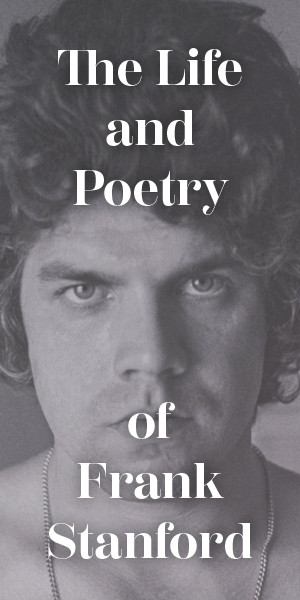Big, Dirty, Beautiful, Defensive, and Obsessed
A Q&A with Jodi Hays
By Robert Alan Grand
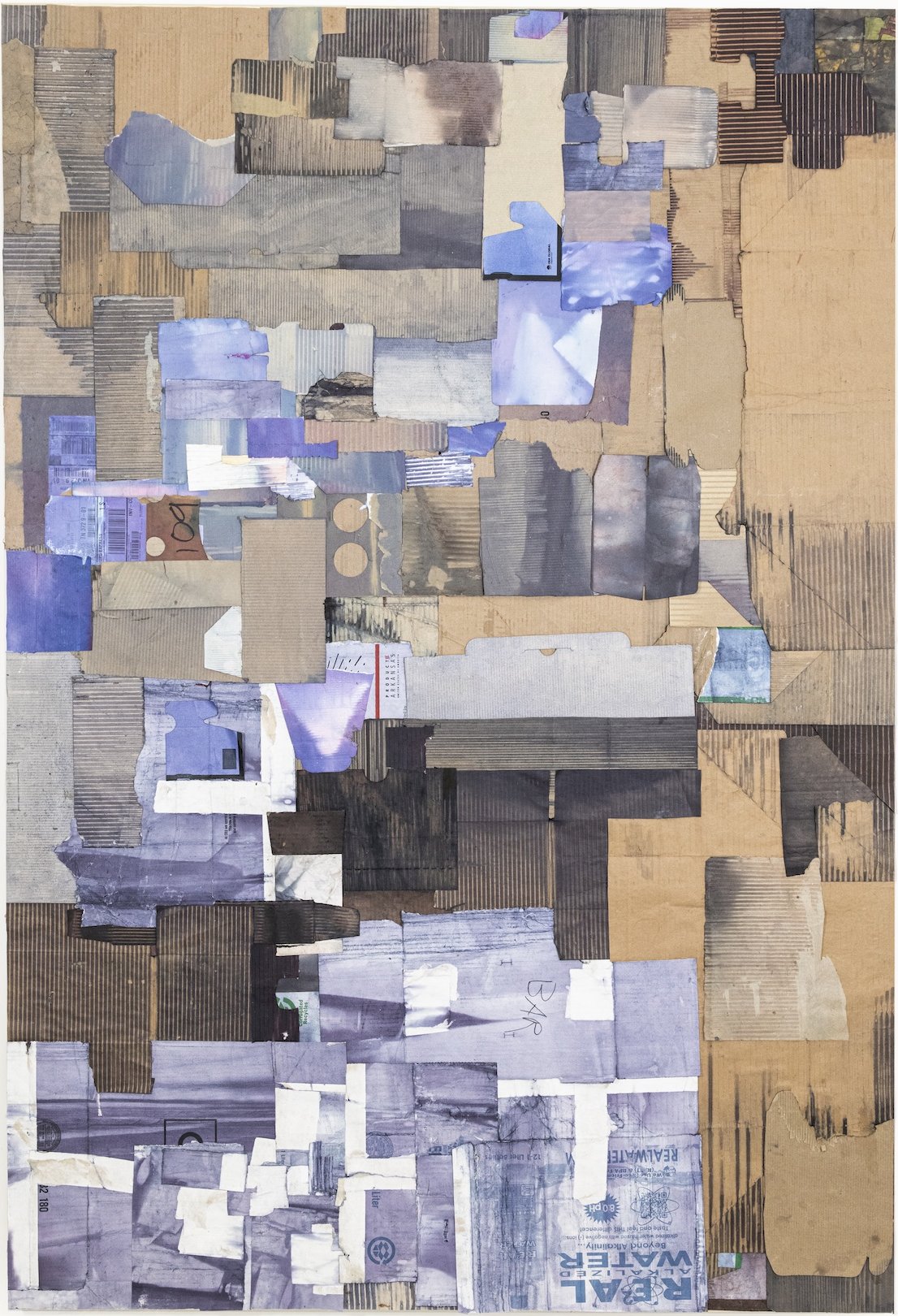
Elaine, 2022, dyed cardboard collage on wood strainer, by Jodi Hays. Image courtesy of Night Gallery
Jodi Hays is resourceful. Her paintings, dyed and bleached cardboard assemblages, harken back to makeshift repairs, temporary solutions. I’m reminded of my neighbor’s penchant for using old boxes as welcome mats during summertime rains. Of Dad duct-taping slices of cardboard to patch the gap when my passenger-side window wouldn’t roll up anymore.
There’s sewing and stitching involved too, making her works reminiscent of quilts—another hallmark of Southern ingenuity. For Hays, today’s feed and cotton sacks are the stacks of Amazon boxes that pile up on our front porches. Packed using a precise algorithm designed to maximize efficiency in a faceless fleet, the boxes are sometimes incongruous with their contents. Plenty of spare material she can use to cover the stretcher bars.
Jodi works out of a Detached Accessory Dwelling Unit (DADU) at her East Nashville home, which she has operated as part of Nashville’s alternative gallery scene. (The gallery is currently on hiatus.) Essentially a backyard cottage, the building complies with the exhaustive zoning codes that the city has recently wielded against other artists. Nashville’s changing urban landscape has always been a focal point of Hays’s work, but now, she reduces the ingredients like one would to create a rich gravy. Her palette is concentrated and powerful, brought to a boil and then cooled again.
Making work about the South, or in the South, can spur a recurring conversation with folks outside of its grasp. There’s a focus on the region’s perceived shortcomings, on its problems, stereotypes, and image, often weighed down with nostalgia. Hays and I are dyed in the wool—raised in Arkansas and South Carolina, respectively—and have always had self-conscious relationships with our homes. Early in our careers, we felt we had to get out, sharpen our wits, and bury our accents. Now, we embrace the influence, settle into its comforts.
For Hays, it often felt like Southern artists were grouped into two buckets: those responding to the region’s fraught history; and those making rigorous, significant work in spite of their location. Looking to break from that, her paintings—with that designation becoming looser by the day—jumble a dewy-eyed image of the South with the modernist grid and the postmodern fascination with signs, symbols, and lexicons. In her blender: Ruscha’s Standard Station; a roadside produce stand; Agnes Martin’s Falling Blue; the complete volume of Foxfire books; Rosie Lee Tompkins’s String; Nashville basements after a significant flood; Rauschenberg’s Bed; a sock factory that’s been transformed into a branch of the SoHo House.
Hays’s works find her playing with preconceived notions—as she says, introducing avant-garde abstraction to “more slant, more slang, more accent, more color, more impulse.” Her amusement creates a path toward reckoning but doesn’t force you to walk down it.
Recently, Hays has had solo and two-person exhibitions at Los Angeles’s Night Gallery, New York’s Susan Inglett Gallery, Western Kentucky University, and Devening Projects in Chicago, speaking to the broadening appeal of her uniquely Southern investigations. Her next solo is with Scott Miller Projects’s new space in Bentonville, Arkansas.
On the heels of her two-person show Cut, Weathered, and Worn opening at the University of Mississippi, and before an upcoming group show at McClain Gallery in Houston, Hays shared a few thoughts with me, reflecting on her work and journey. The following conversation has been edited and condensed.
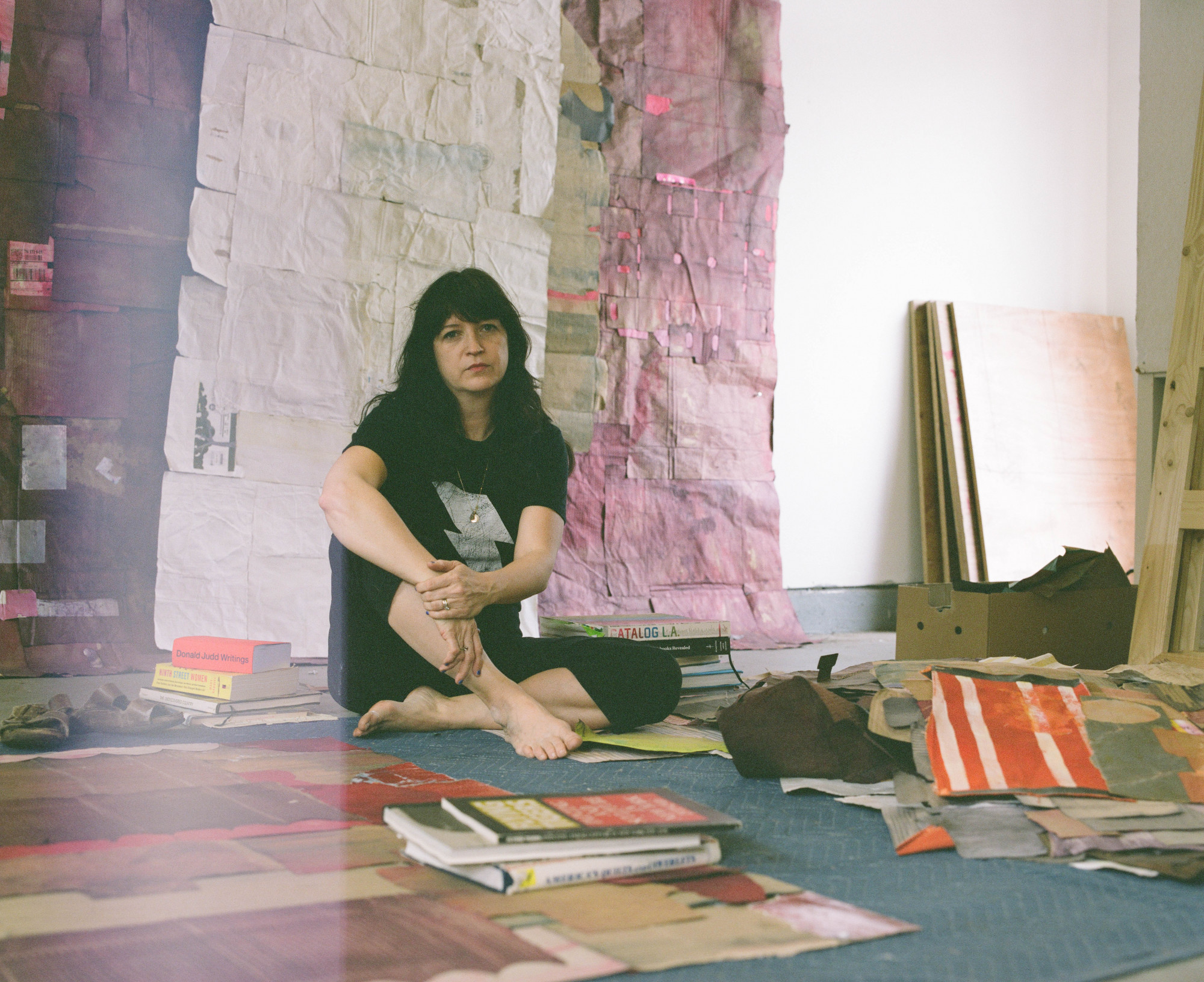
Photograph of Jodi Hays by Logan Elder. Courtesy Jodi Hays and the artist
Robert Alan Grand: For those unfamiliar, can you describe your process?
Jodi Hays: I make abstract paintings and collages. To generate material, I sink paper, cardboard, and textiles into dye and bleach baths. The color or bleach seeks the valleys in the cardboard, resulting in collage material with a pattern of parallel lines. After drying, these are my palette, though I also use paint with discretion. What first struck me about it was its hidden-ness, unless you separated out the material. And secondly, the way a simple process or job, connecting me with women and labor for generations, created such a subtle and stunning substrate.
What do you attach them to? Canvas? They seem to just float.
I have let them float, like tapestries. I have also mounted them on stretchers so they act like paintings. Currently I am affixing them to aluminum bars and flat sheet aluminum material. And then some are like regular paintings.
You still refer to these pieces as paintings, right?
I do. Lately I have been wondering if my insistence—and that of many others in my orbit—is just a holdover of a time when painting’s borders were more fiercely patrolled. My reasoning thus far has been to help widen the definition of what we assume painting can be, and who is “allowed” to be part of this rich history of the medium. I am seeking out those very much perceived and invented borders less stridently these days, and am enjoying seeing where materials and text take me.
Your work took a drastic shift during the early days of lockdown—how did you come upon this new way of working? Did the pandemic have any influence on it?
As early as 2018, sewing and piecing were apparent in my process, pointing to the architecture of a painting (wood, linen, canvas, paint). I can trace this impulse years earlier in my work too. Once the pandemic hit, like many of us, I was home sorting through material and cleaning my backyard studio. It was then that I found my way to the current process of manipulating reclaimed materials, marrying ideas on the art historical grid with housework, consumerism, and, in some ways, our global connectivity via goods and packaging. I am still considering if these leaps would have been made so quickly outside of the stress of 2020. Like everyone, I could write a book.
Tell me about the new pieces incorporating metal and Dibond.
In the same way that a scallop is repeated in my work, I am questioning if a material can do a similar thing—create a break or comment to the heavily textured material. Metal is in opposition to the warmth of a cloth or worn-in-ness of a discarded box. Metal is also an industrial, rather than a domestic, material. I think it is working so far. I have a solo show of these new works at Scott Miller Projects [in] Bentonville in the fall.

The Exceptions, 2023, cardboard and textile collage on aluminum and found wood stretcher, by Jodi Hays. Photographed by Sam Angel. Courtesy the artist
You’ve described your work as building a “visual lexicon” of the South. For me, the cardboard layers harken back to patchwork quilts, and boxes found in rundown factories and farmhouses.
Defining the South and its placement in my work is really tough because the work is not derivative in a nostalgic way, but I use that nostalgia as material to get someplace deeper. Down here is big, dirty, beautiful, defensive, and obsessed. I am not always comfortable with the term “Southern artist” in the same way that the subjects of Ninth Street Women [by Mary Gabriel]—Krasner, de Kooning, Haritgan, Mitchell, and Frankenthaler—just wanted to be “painters” [rather than “women painters”]. If my whole practice is a river, then I have these little creeks that feed it. Some streams are the arch of a doorway, the scalloped shape of fingertips, the squares of gingham flannel, cardboard boxes of 78s, a field of row crops, corrugated tin roofs, a burn pile, a playlist. This lexicon is not limited to the South, but my experience is.
Yes, I think of Elaine de Kooning’s quote from that book, “To be put in any category not defined by one’s work is to be falsified.” Does that resonate with you? I don’t think “Southern artists,” like “women artists,” carries the same stigma it once did.
Perhaps “Southern artist” was, for a time, synonymous with “outsider artist” and has historically excluded artists whose work are rooted in a comprehensive narrative or knowledge of art history. And as Helen Molesworth recently said in an interview [with Scratching the Surface], “The omissions shape me more than the inclusions.” A goal is to be defined by one’s work, not one’s gender, pedigree, race, geographic location—any of these biographical ideas that have been used against an artist to limit how large their vision might be. But, to enjoy the freedom to pick up on what these ideas have taught you, and how they might inform your personal idiosyncratic art and practice, is also the goal.
You grew up in Arkansas, spent some time in NYC and Boston, and have been in Nashville since 2005. What does the South mean, or encompass, to you? What are some other hallmarks of your own Southern lexicon?
The South, defining it, is a pendulum swing. On one apex you’ve got those not from here who have assumptions. One the other swing you’ve got those of us in it, from it, who see the whole project of “The South” departed from those assumptions. I bristle at the mention of Hee Haw as who we are, and yet I grew up going to a sale barn with my Papaw most Saturdays. I am from a misunderstood place—Arkansas, specifically—that only a few even know about, really. History, story, family, faith, hypocrisy, onus, blues, seduction are all words that come to mind. Sometimes, all I can see is darkness and damage connected to our shared history. Then other times, my kids show me light and change is here too.
I love that someone described your paintings in your Night Gallery solo show as “humid.”
They hang heavy. They are dense. I love seeing the work in bright, arid California—also an idea as much as a place—and how it can be read depending on [the] situation.
Your work also has a sustained engagement with abstract expressionism and early postmodernism. How do these historical styles shape your process?
[In] the earlier work [I] made reference to signs and a painted mark or brush stroke, like many good students of painting. This conversation is linked to place, and taste, and not dissimilar to use of text in Robert Rauschenberg, Jasper Johns. I was thinking, how can I imbibe this visual history with more slant, more slang, more accent, more color, more impulse?
I feel like this passage hints at the “truth” of your work, and why it has this buzzing energy around it. I know the phrase “Southern artist” is fraught, but doesn’t this feel like a justification of sorts? Bringing a Southern, spunky energy to these modern masters and expanding the realm of what’s possible. I see such a strong connection to craft, also historically devalued, gendered, and wrapped up in nostalgia—again, pushing it into the realm of painting and showing the two were never so different from the start.
Very early work that landed me a spot at [an art school] was quasi-expressionistic aerial view paintings of the Mississippi River, titled with Willie Nelson lyrics. Perhaps heavy-handed, but these works from twenty years ago reflect my early interest in quilt-like visual situations. Continuing my interest in landscape, I based my MFA work on images of desolate or transitional urban landscapes, eerie takes on the view out an airplane window. At some point I dropped the reference images and let the materials of paint, then paper and cardboard, then textiles and craft, just take over like kudzu. Lately I am reading The Slip [by Prudence Peiffer, which outlines] a community making work marked by use of found material, including those that often define craft, but also the same materials that define labor. Similarly, I want to make art by leveraging shared material, with marks that are painted, yes, but also sewn, written, felt, dabbed, wiped, affixed, and drained. The new work synthesizes a lot of my early hunches.
To throw a lot at once: Why stick with contemporary painting? Why not make a motion towards craft? Why not make cardboard quilts instead? Why have your works hang on a wall?
Perhaps it’s just an overreliance on my siloed painting education. I am making cardboard quilts. Quilts are ubiquitous, not always very tasteful, and generally mother-made. I think I am reluctant to define the work as craft because I have such high standards for it. In my mind, craft is tied to excellence and perfection, and mostly function. Some craft heroes include Anni Albers, who made those drawings from a broken typewriter at Black Mountain College. Some of my recent works are expanding, shaped and placed on the floor, maybe owning up to the piles of lumber and feed sacks I jumped on in my Dad’s hardware store. Or the aisles of my grandfather’s grocery store. Or my grandmother’s stack of scarves in her closet.
Your approach to mark-making also takes plenty of inspiration from writing. You quote poet C. D. Wright frequently.
C. D. Wright’s writing rings true to me, every single word of it. I know we are art cousins, but are probably also blood cousins (my mother is a Wright). Perhaps my understanding of C. D. Wright’s voice has to do with finding a model for the life I have made by someone from the same dirt as me. One of my regrets is not having ever met her.
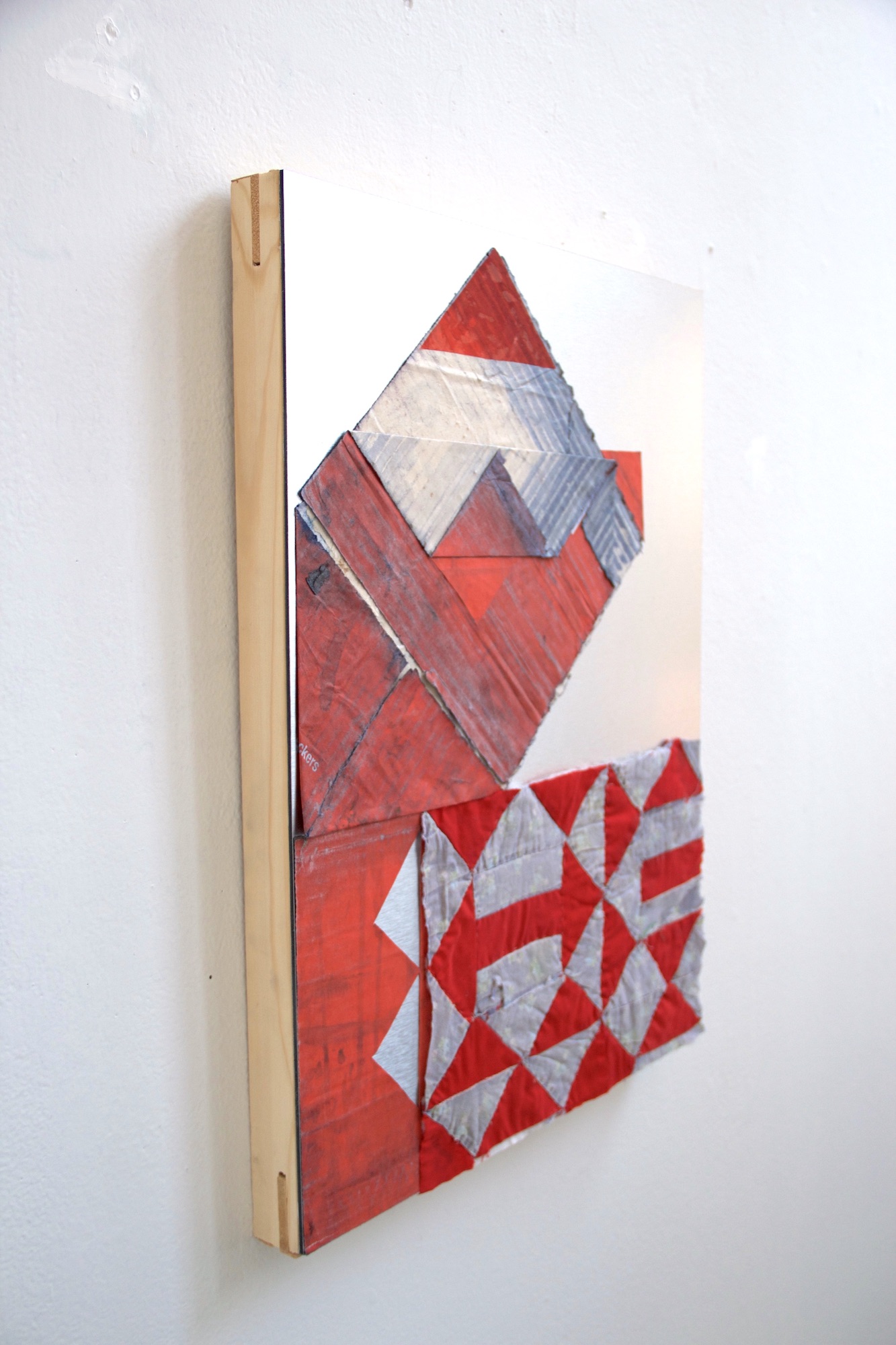
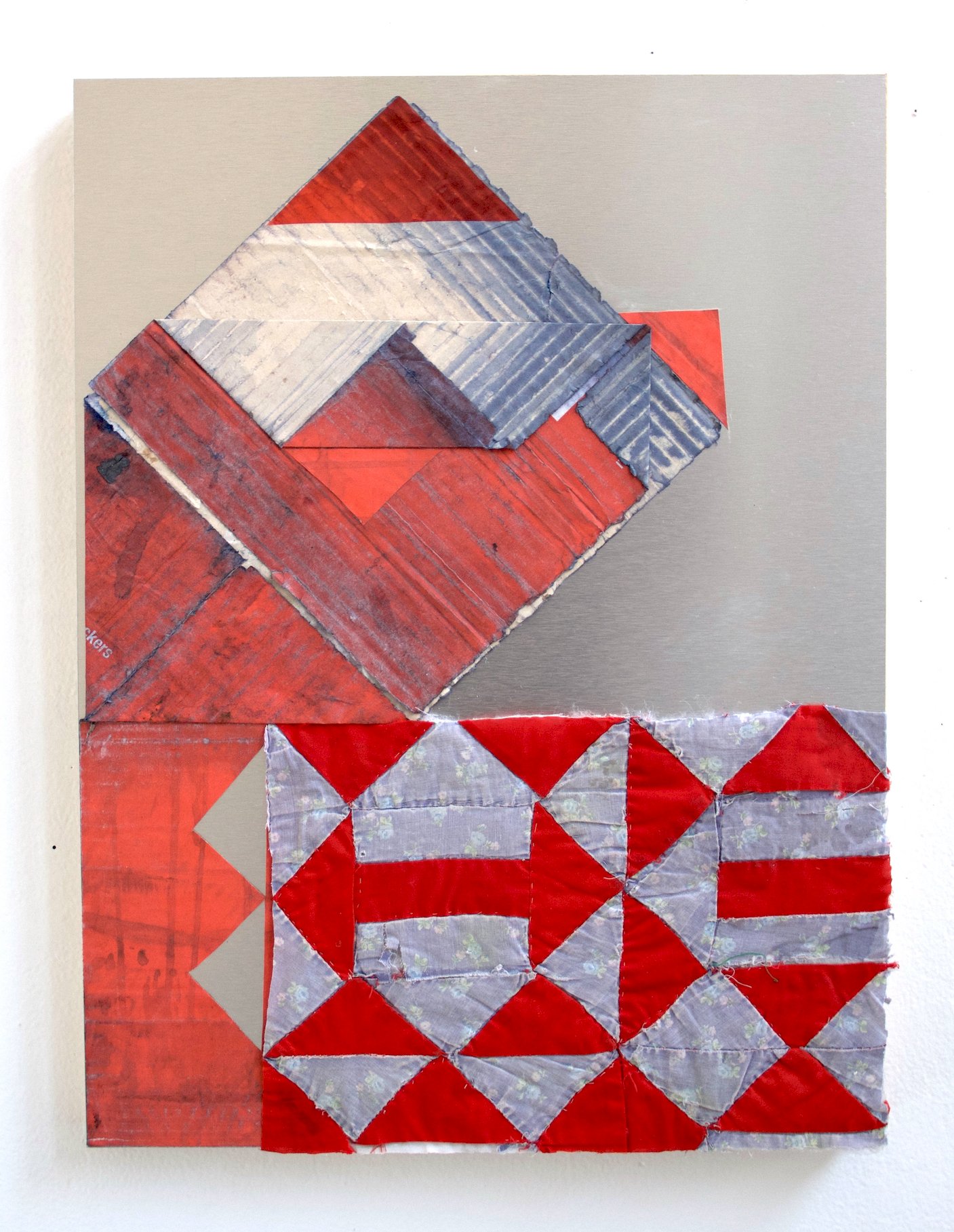
Brother Jones, 2024, dyed cardboard, vinyl, and deconstructed quilt collage on aluminum Dibond and wood panel, by Jodi Hays. Images courtesy the artist
What’s encouraged you to stay in the South?
Affordable housing; family; childcare help; a curating job I loved; ease of making, by comparison. And I also get to understand the placement of “outside.” I held a very stubborn belief early on that one can make consequential, important, and relevant work outside of, and in informed conversation with, more habitual art historical spaces and temperaments, like those on the coasts. I am seeing that stakeholders in the art world outside of our region are taking notice. I am told I mostly live in my head, anyway.
I’m turning the tables and pulling a C. D. Wright line on you—in Cooling Time: An American Poetry Vigil, she wrote, “I believe in a hardheaded art, an unremitting, unrepentant practice of one’s own faith in the word in one’s own obstinate terms. [...] Important, I believe, to resist finality in one’s own work while assiduously working toward its completeness.” How does this passage resonate with you? How do you resist finality in your process and art?
Her description of art is one that defies categorization. One that can change, will change. I feel like she is talking about excellence without stagnation. Searching? I follow my nose, and it can sometimes get me into trouble.
Below, listen to a playlist of songs that inspire Hays—and other Southern artists in her orbit, whom she solicited for recommendations. For more stories that celebrate visual art, order a copy of the Oxford American’s Southern Art Issue.



